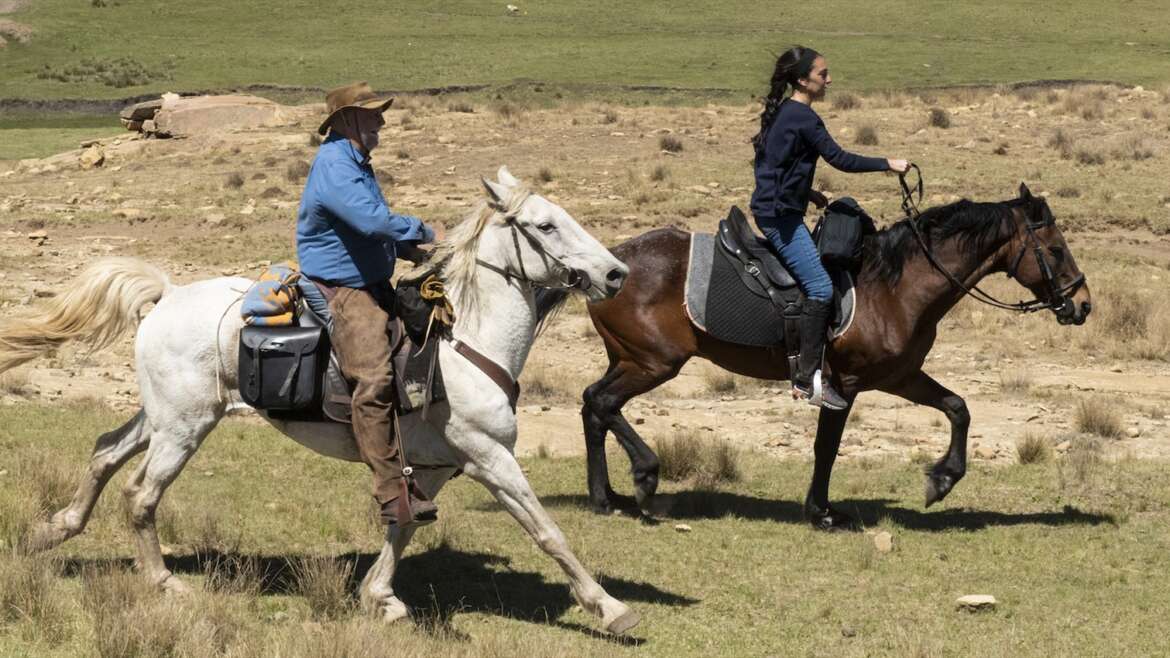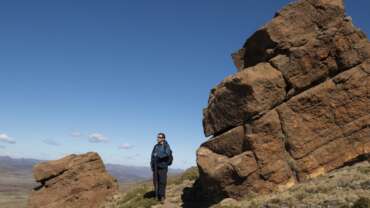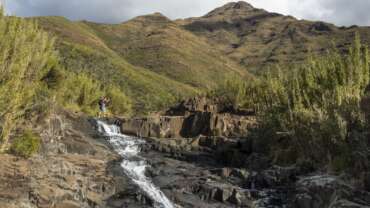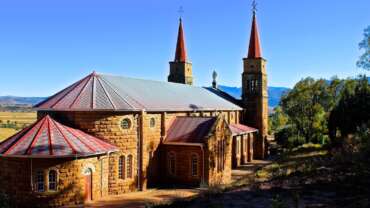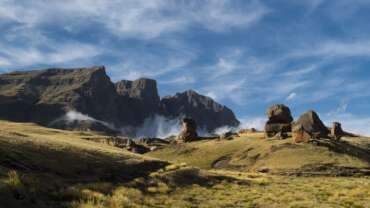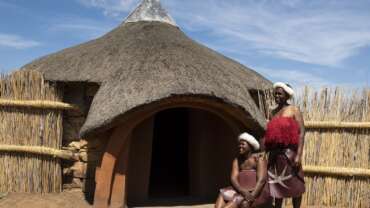Adventure Activities in Lesotho
Outdoor adventure is what Lesotho is all about. With its unfenced highland vistas, unpolluted mountain air and predominantly rural population, the remote and mountainous “Switzerland of Africa” is an ideal holiday destination for active travellers seeking respite from the urbanisation, 24-hour connectedness and other trappings of modern civilisation.
Key to Lesotho’s outdoor appeal is an organic network of bridle paths that crisscross the kingdom, passing through undulating green meadows scattered with colourful wildflowers, climbing uphill between towering sandstone escarpments to lofty basaltic plateaux, or winding down into verdant gorges carved by babbling mountain streams.
Created by generations of Sotho shepherds and horseman as they travelled between village and grazing pasture, these ancient bridle paths provide visitors with innumerable opportunities for hiking and trekking, trail running and horse and pony trekking through the breathtaking mountain scenery typical of Lesotho.
The sparkling mountain streams and rivers of Lesotho are ideal for fly-fishing for trout and yellowfish.
Birdwatchers can look forward to a checklist of more than 350 species, including a wealth of localised regional endemics and other highland specials.
The rocky escarpments that scar the highlands are tailor-made for climbing and abseiling, or as launching points for paragliders and hang gliders.
For 4×4 enthusiasts, it’s possible to divert from the asphalt to explore some seriously challenging unsurfaced roads, among them the spectacular Sani Pass and Matabeng Pass, as well as he more extreme Tlaeeng Pass, which ranks as the highest road in subequatorial Africa, summiting at 3,275 metres.
Less expectedly perhaps, Lesotho is one of Africa’s highest countries, and far enough from the equator that it hosts one of the region’s only two skiing and snowboarding destinations in the form of Afriski Mountain Resort, whose ski slopes operate over the midwinter months of June to August.
Skiing and Snowboarding
Given that Lesotho boasts the highest average altitude of any country in Africa, and lies well outside the tropics, it should come as no surprise that its loftier reaches are often blanketed with snow for part of the winter, or that people first skied there in the 1920s.
Commercial skiing in Lesotho dates back to 2004 when Afriski Mountain Resort opened in the part of the Maluti Mountains closest to the northern border with South Africa, an Afroalpine region often referred to as the ‘Roof of Africa’. Afriski is the highest of sub-equatorial Africa’s only two skiing and snowboarding destinations, perched at an altitude of 3,050 metres, and in midwinter it attracts a steady stream of devoted and aspirant skiers from Johannesburg, only a half-day’s drive to the north.
Skiing and snowboarding at Afriski are restricted to the midwinter months of June to August. Even at this chilliest time of year, however, a natural cover of skiable snow cannot be guaranteed. As a result, Afriski operates a battery of 34 snow cannons to supplement the natural snowfall, thereby ensuring that its main 1km slope and two beginner slopes are always skiable in season. Conditions permitting, there is also a longer natural ski run at the nearby Mahlasela Pass, which rises to 3,222 metres immediately west of the resort.
Afriski operates much like any European ski village, offering ski lifts to transport guests up the slopes, ski equipment for hire, and tuition as required. It also has accommodation facilities for up to 150 people, and it is the site of Africa’s highest restaurant.
Hiking and Trekking
It is no exaggeration to describe Lesotho as a hiker’s paradise. There are practically no restrictions on hiking through the kingdom’s unfenced highlands, soaking up the spectacular scenery and enjoying the unforced hospitality of its rural inhabitants as you follow a network of informal bridle paths forged over the centuries by Sotho horsemen and shepherds.
Inexperienced hikers seeking accessible and well-marked trails are pointed to Ts’ehlanyane National Park, where a good network of footpaths – ranging from the short and flat Lower Trail to the Black Pool to a demanding Circular Trail past the lovely Matsa Mararo Falls – emanates out of the upmarket Maliba Lodge, which can supply a suitable map or local guide by request.
A more remote but equally straightforward goal for hikers is Sehlabathebe National Park, Here, guides are optionally available to explore a network of trails that traverses a spectacular landscape of rock arches, highland pools and ancient bushman paintings set below the lofty peaks known as the Devil’s Knuckles.
For dedicated peak-baggers, guides are available at Sani Top for the nine-hour round hike to Thabana Ntlenyana, whose 3,482-metre summit is the highest point anywhere in Africa south of Kilimanjaro. An equally beautiful but less demanding four- to five-hour round hike leads from Sani Top to Hodgson’s Peaks, offering some wonderful views over the escarpment along the way.
Other recommended destinations for relatively undemanding guided or unguided day hikes include Semonkong, where you can walk to a viewpoint facing the single-drop 192-metre Maletsunyane Falls or follow a steeper footpath to the gorge below it, and Malealea Lodge, which offers hikes to various waterfalls and rock art sites. Hiking trails out of Afriski Mountain Resort range from around two hours to a full day in duration.
For more dedicated hikers, it is possible to hike the entire eastern Drakensberg escarpment from Mont-aux-Sources in the northwest to Sehlabathebe National Park in the southeast, seldom dropping below 3,000 metres in the process. Particularly recommended is the 40km, 3-day hike along the sensational section of escarpment connecting Sani Top to Sehlabathebe. Guides are available at Sani Top if required, but experienced and self-sufficient hikers with suitable maps and provisions can undertake it as an unguided trek.
Because most of Lesotho lies well above the 2,000-metre, it offers ideal high-altitude training to hikers planning to tackle loftier targets such as Mount Kilimanjaro. It should be noted, however, that weather conditions in the mountains tend to be fickle, and mist, rain, hail and even snow can descend with little warning at any time of year. Overnight hikers should be in possession of good walking shoes, a warm sleeping bag, plenty of warm and waterproof clothing, detailed maps, and sufficient food and water. Camping is permitted anywhere in the kingdom and it is also often possible for hikers who don’t carry a tent to rent a hut in a local Basotho village.
4×4 Adventures
Although most trunk routes in Lesotho are now surfaced and easily traversed in any roadworthy vehicle, the more remote corners of the kingdom still offer great opportunities for 4×4 enthusiasts to hone their skills in magnificent montane settings.
The most famous 4×4 route in Southern Africa, Sani Pass links the small South African town of Underberg, at the base of the uKhahlamba-Drakensberg escarpment, to 2,874-metre Sani Top in Lesotho. Sani Pass follows a thrilling succession of rocky switchbacks as it climbs almost 1,500 metres over fewer than 20 kilometres, offering sensational views in all directions. Although it can be driven independently, Sani Pass can also be explored on an organised day tour out of Underberg, one that also provides a great introduction to Sotho culture and Afroalpine ecology, as well as the opportunity to lunch at the highest pub in Africa.
Another excellent albeit more demanding 4×4 route connects Sani Top to Sehlabathebe National Park via Matabeng Pass, a stunning – but after rain, or rockfalls, potentially treacherous – road that summits at 2,940 metres and is traversed by no more than a handful of 4x4s daily. The full drive from Sani Top to Sehlabathebe should take around eight hours if all goes well, but it is advisable to leave as early as possible and to stock up on provisions at the well-equipped small town of Mokhotlong. The reward for all this hard work is some superb views over the sweeping Senqu (Orange) and Sehonghong rivers, followed by few days rambling or hiking in the gorgeous Sehlabathebe National Park.
Another great (mostly) 4×4 route runs southwest from Sehlabathebe National Park to Quthing via Qacha’s Nek, following the Senqu River for much of its length, with must-do diversions to scenic Lake Letsie and the Tsatsane Bushman Paintings.
Possibly the most extreme 4×4 route in Lesotho is the 60km track that runs northeast from Ha Lejone in Katse Dam to the A1 south of Oxbow and Afriski via Tlaeeng Pass, which summits at 3,275 metres, making it the highest road in subequatorial Africa.
Although Sani Pass is traversed by dozens of commercial 4x4s daily, the other routes described above are very remote and should only be attempted by experienced and self-sufficient drivers in reliable vehicles carrying suitable spares. Rockfalls and sudden rainstorms (sometimes accompanied by hail) are a potential hazard in summer, while snow and black ice require extra care in winter, especially at higher altitudes.
Cycling and Mountain Biking
Mountain biking is a fantastic way to appreciate the small mountainous kingdom of Lesotho. Whether you book onto a short morning or afternoon cycling excursion or embark on a more adventurous multi-day expedition, the majestic highland scenery, unique flora and fauna, picturesque stone-and-thatch villages – not to mention an abundance of unsurfaced country roads and well-worn bridle paths – make Lesotho a cyclist’s paradise.
Many of Lesotho’s best-known travel hubs offer guided or unguided cycling packages ranging from a few hours to five days or longer in duration. These include Malealea Lodge in Malealea, Semonkong Lodge near the Maletsunyane Falls, and the Roma Trading Post outside Roma. A popular centre for high altitude cycling training in summer is the Afriski Mountain Resort, which stands at an altitude of 3,050 metres in the Maluti Mountains.
For experienced and self-sufficient cyclists, Lesotho offers plenty of opportunities for self-guided exploration. The eastern half of the country is particularly exciting in this respect, following a route connecting such off-the-beaten-track delights as the Tsatsane Valley, Lake Letsie and Sehlabathebe National Park north towards Sani Top. But in truth there are very few parts of Lesotho that aren’t suited to mountain biking.
Lesotho hosts three exciting annual mountain biking events in September and October. The Lesotho Thin Air Challenge is not a race, but a challenging and scenic four-day adventure aimed at experienced cyclists. Limited to 100 participants, the Lesotho Sky Stage Race, a six-day event that takes in several iconic mountain passes and many remote bridle paths, is fully supported inclusive of accommodation, meals, water points and medical support. By contrast, the Malealea Monster, held every September at Malealea Lodge, is a more relaxed family-oriented race with four different courses, ranging in length from 8km to 75km, to accommodate most skill levels.
For experienced off-road motorcyclists, the cross-country Roof of Africa Rally is a challenging multi-day annual event that was first held in 1967 and now usually takes place in early December.
Horse Riding and Pony Trekking
The most popular mode of transport in rural Lesotho is the Basotho pony, a unique breed of horse distinguished by its relatively small size, robust build and unusually long stride. It is also known for its sure-footedness, calm temperament and stamina in mountainous terrain.
Pony and horse trekking is one of the finest ways for a visitor to explore the extensive network of bridle paths that crisscrosses the mountains of Lesotho. Short treks of a few hours’ duration can be arranged in many parts of the kingdom, providing novice riders with an excellent introduction to rural Basotho culture.
More rewarding for experience riders would be to arrange a multi-day pony trek supported by additional pack animals for gear and provisions. Most such treks stay overnight in a succession of remote high-altitude villages where you can completely escape the high-octane trappings of modern civilisation and gain intimate experience to rural Basotho culture and hospitality.
The Basotho pony has an interesting progeny. Java ponies were first introduced to the Cape in the 1650s and subsequently interbred with taller and more elegant Arabian and Persian horses to create a distinct breed called the Cape horse. During the early years of Moshoeshoe I’s reign, Cape horses captured from neighbouring Zulu and Boer territories were brought to the kingdom and bred selectively to create a smaller and sturdier horse suited to its mountainous terrain. The resultant Basotho Pony, recognised as a distinct breed in the late 19th century, would go on to be favoured for its hardiness by both protagonists during the Anglo-Boer War of 1899-1902.
Today, the main pony and horse trekking centre in Lesotho is Malealea Lodge, which works in conjunction with the local community to offer a wide range of guided treks. These include half-a-dozen different day outings that range from two to seven hours in duration, taking in nearby landmarks such as waterfalls and rock paintings, as well as a few longer options, the most elaborate being a six-night cross-country trek to Semonkong and Maletsunyane Waterfalls.
Pony treks can easily be arranged in mosts other parts of Lesotho though lodges or local tourist guides. Rewarding pony trekking routes exist in Sehlabathebe National Park and Ts’ehlanyane National Park, as well as in the vicinity of Sani Top and the Tsatsane Bushman Paintings.
Bird Watching
Lesotho is a highly rewarding ornithological destination. Despite being one of the smallest countries in Africa, it boasts a checklist of 350 bird species, and is the best place in the world to tick a number of alluring specials endemic to the upper reaches of a biodiversity hotspot known as the Drakensberg Alpine Centre.
High-altitude specials whose range is centred on Lesotho include the Drakensberg rockjumper, a handsome orange-breasted bird often seen running and hopping between boulders around Sani Top and Bokong Nature Reserve, and the conspicuously vocal and rather canary-like Drakensberg siskin.
Lesotho and the neighbouring uKhahlamba-Drakensberg region of South Africa also form the core range of a number of whose range is restricted to Lesotho, South Africa and/or Swaziland. Most conspicuous among these, often seen foraging in small flocks in open grassland, is the striking southern bald ibis, but look out too for the ground woodpecker, yellow-breasted pipit, mountain pipit, buff-streaked chat and bush blackcap.
Gurney’s sugarbird, one of two species assigned to a bird family unique to Southern Africa, is a striking highland nectarivore with a longish tail, russet breast band, bright yellow vent and heavily curved bill. It is most likely to be seen feeding on with flowering proteas, aloes and red-hot-pokers, often alongside the malachite sunbird, a spectacular long-tailed nectarivore with iridescent green feathering.
Other Southern African endemics likely to be encountered in parts of Lesotho include grey-winged francolin, forest buzzard, large-billed lark, African rock pipit, yellow-breasted pipit, chorister robin-chat, buff-streaked chat, sentinel rock thrush, pied starling, southern double-collared sunbird, greater double-collared sunbird, Cape weaver and forest canary.
The craggy escarpments of Lesotho form an important breeding site for cliff-nesters such as jackal buzzard, Cape vulture, Alpine swift and red-winged starling. These cliffs also support the southern hemisphere’s only viable breeding population of the bearded vulture, a massive raptor with a 2.75-metre wingspan and a unique habit of dropping bones from a great height onto a rock slab to crack them open to eat the marrow.
For those seeking highland specials, Sani Top is probably the most rewarding individual site in Lesotho (indeed, Roberts Bird Guide ranks it and the associated Sani Pass among the top ten birdwatching localities in South Africa/Lesotho). Bokong Nature Reserve and Sehlabathebe National Park are also excellent for high-altitude species, while Lake Letsie excels for wetland birds and Ts’ehlanyane National Park is strong on woodland dwellers.
Fishing
The unspoilt highland streams and rivers of Lesotho are renowned for offering superb technical fly-fishing in a pretty and dramatic mountainous setting. Typical catches include brown trout, rainbow trout and smallmouth yellowfish, all of which were introduced by local anglers in the 1950s, while the indigenous barbel and Maloti minnow tend to be found at lower altitudes.
The fly-fishing season opens each year on 1 September and closes on 31 May. However, rivers tend to slit up between December and February, the height of the rainy season, which adversely affects the quality of fishing, so the peak seasons are from September to November and from March to May.
It is advisable to go with a local guide, who will know the best fishing spots, and can also arrange suitable licences and advise whether permission from any local chief is required. Guides can be arranged through most lodges and hotels that stand close to popular fishing locations and regularly cater to international visitors, for instance Semonkong Lodge, Malealea Lodge, Roma Trading Post, Katse Lodge, Mohale Lodge and Maliba Lodge. For those spending longer in the country, monthly and annual licenses can be obtained directly from the Lesotho Highlands Development Authority.
Equipment that may be used for trout fishing is limited to a rod, line and artificial non-spinning flies. Landing nets and gaffs are not permitted. The bag limit for trout is twelve specimens of at least 25 centimetres in length. Any smaller or excess trout must be returned to the water. Trout fishing is not permitted at all over the midwinter months of June to August, which is closed season.
Popular and relatively accessible fly-fishing spots include the following:
Katse Dam
– The main reservoir, where a floatation device may be required
– The Malibamat’so and Pelaneng confluence 2km upstream from Motebong lodge in Ha Lejone.
– The Pelaneng river valley, a few kilometres upstream from the Malibamat’so confluence.
Mohale Dam
– Makhaleng River, 2 km below Molimo Nthuse Lodge.
Oxbow and Afriski
– The confluence of the Ts’ehlanyane and Tlholohatsi Rivers about 2km from Oxbow Lodge.
– The Malibamat’so River 2 km below Oxbow Lodge.
– Sehlabathebe National Park
– Tsoelikana River downstream from the waterfall of the same name.
– The ponds of the near the old Sehlabathebe Lodge.
– Leqooa River, a four-hour pony trek from the old lodge.
Semonkong
– Maletsunyane River upstream of and at the bottom of the Maletsunyane Falls.
Abseiling and Rock Climbing
The rock faces and peaks of Lesotho offers a wealth of opportunities to adventurous rock climbers and abseilers with suitable experience and equipment.
Maletsunyane Falls, near Semonkong, is the setting for the world’s longest commercial single-drop abseil. The 204-metre descent alongside one of Africa’s tallest single-drop waterfalls is a truly breathtaking experience, one that frequently leaves you suspended against the rock face with a fine spray blowing into your face. The views to the verdant gorge below are sensational too. A good for heights is a prerequisite, but despite the length of the descent, no experience is required, since advance training is given to all abseilers on a smaller cliff.
Paragliding and Hang Gliding
The spectacular mountains of Lesotho offer ideal conditions for hang gliding and paragliding. The mountain air is delightfully fresh, and visibility tends to be good, while wind conditions are often perfect. The preponderance of cliffs throughout the country also means there is no shortage of potential launching sites. As things stand, however, no commercial hang gliding or paragliding operators exist in Lesotho, and no specialist equipment is available for hire, so the country is only suited to experienced gliders with their own gear.
Trail Running
Lesotho offers some the world’s best conditions for high-altitude running. The vast network of informal bridle paths that runs through the kingdom’s scenic highlands is primarily used by Sotho shepherds and their livestock, but these ancient tracks are also ideal for experienced trail runners wanting to gain experience at medium to high altitudes, ranging from 1,400 metres to 3,200 metres.
Great opportunities for trail running exist almost throughout Lesotho. The clearly signposted dirt road and trails that run through the country’s two national parks Sehlabathebe and Ts’ehlanyane make for a good starting point. However, with suitable gear, such as GPS, water bladder and so on, one could treat almost any footpath in the country as a potential trail run, including the ascent from Sani Top to Thabana Ntlenyana, the tallest peak in Africa south of Kilimanjaro.
Although Lesotho holds a special appeal to off-road runners, the country’s network of surfaced and unsurfaced roads also provides plenty of opportunities for road runners and other athletes to work on hill and altitude training. Except in the immediate vicinity of Maseru and a few other large towns, roads in Lesotho tend to be very quiet, and safe for running.
A particularly good spot for high altitude training is the Afriski Mountain Resort, which stands at above 3,000 metres in the Maloti Mountains and is surrounded by roads and trails suited to both type of runner. Between mid-September and mid-May, Afriski also offers regular high-altitude training camps supervised by an experienced personal trainer and coach.
For racers, the kingdom’s most challenging event is the Lesotho Ultra Trail held annually in Ts’ehlanyane National Park every November since 2013. This testing circular 50km ultra-marathon entails a total altitude gain and loss of around 2,500m over two main ascents and descents, and it peaks at around 3,155 metres from a low point of 1,950m. There is also a slightly less demanding 38km variation entailing a total altitude gain and loss of around 1,700m.
A less hardcore event is the Malealea Monster Weekend of Adventure held at Malealea Lodge every September. This family-orientated event comprises a mountain biking race with four options ranging from 8km to 75km on the Saturday, then the choice of 8km, 15km and 25km trail runs on the Sunday.



